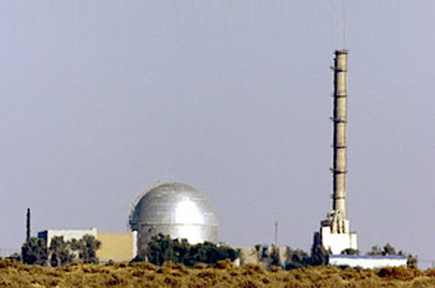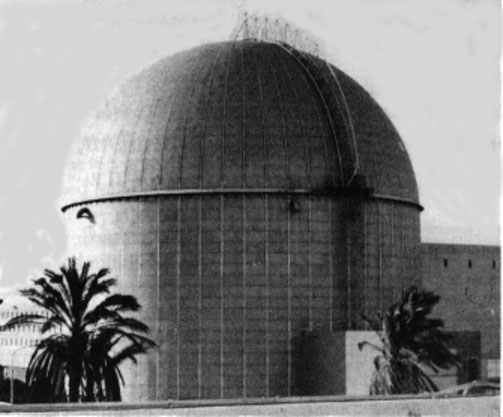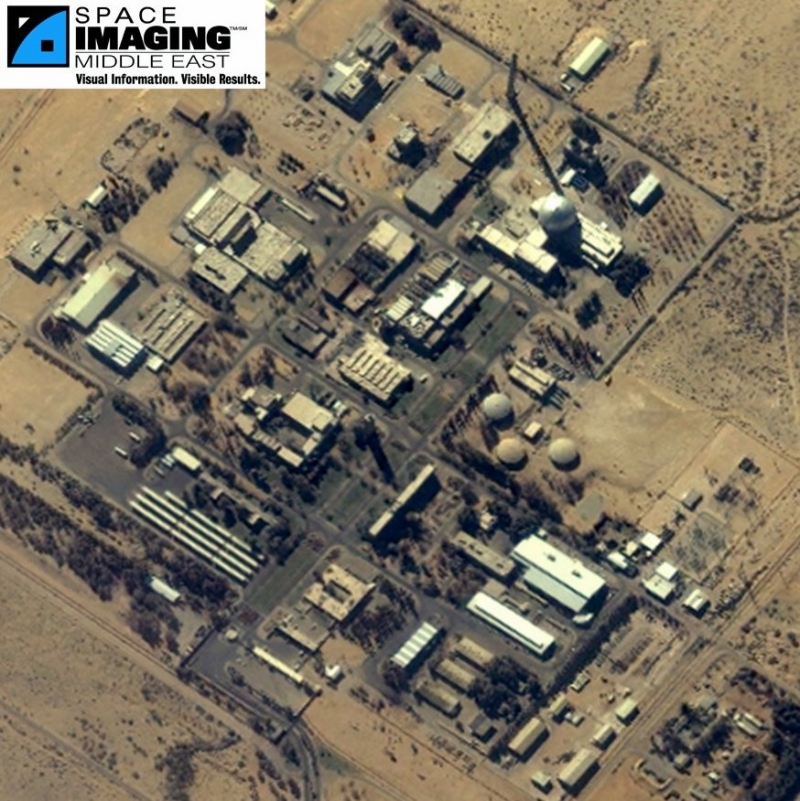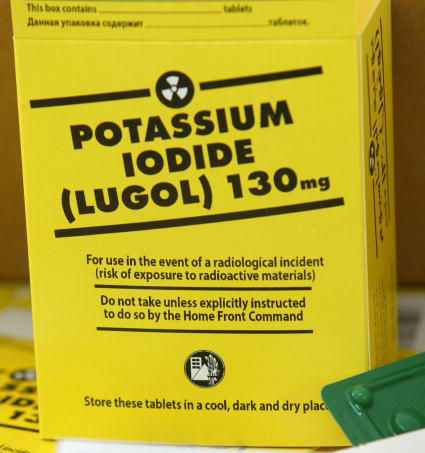 |
|
||||||||||||||
|
The Dimona Plutonium Nuclear Reactor |
|||||||||||||||
|
The Dimona nuclear reactor is used to produce plutonium used in atomic bombs. The reactor was purchased from France as part of a secret agreement related to the Suez War, in which the I.D.F. in collaboration with France and England conquered the Sinai Peninsula. Construction of the reactor started late 1957 or early 1958 and was completed in 1962. It began operation (became critical) in 1963. The reactor is one fueled by natural uranium and deuterium. The French (via the Alsace Corporation) delivered a reactor with a capacity of 24-26 megawatts, which was secretly increased by Israel, first to 70 megawatts and later to 150 megawatts. Israel tried to argue that the reactor was used for all sorts of civilian and peaceful purposes, certainly not for the production of nuclear weapons. These were all lies; even water desalination and the cultivation of the Negev were used as arguments in order to conceal the true nature of the reactor. This is what David Ben-Gurion had to say on these issues when speaking to the Knesset on December 1960, when the plan to construct the reactor first became public (taken from Avner Cohen's book 'Israel and the Bomb'):
It is clear today that apart from the figures regarding the capacity, nothing said by Ben-Gurion was the truth (and even the capacity was covertly increased, due to the meager amount of plutonium it produced, which hardly sufficed to produce a nuclear bomb). Ben-Gurion was not content with this one false statement. To a second question, posed by MP Dr. Unichman from the Herut opposition party, "what is the source of the report that Israel is building a nuclear bomb?" Ben-Gurion responded: "The source of this report is erroneous either on purpose or not" (from Vanunu and the Bomb by Gideon Spiro, page 148, Hebrew). Source: Maariv (Hebrew). The reactor from its beginning was part of a secret project of the Defense Ministry and the office of the Prime Minister. It was never designed as an electricity production facility and was not intended for research. It was never 'open', and thus never entertained academics from around the globe. It was never used for industrial purposes either. According to Mordechai Vanunu's account the reactor produced 40 kilograms of plutonium a year. The estimate is that until the mid-70's Israel produced 200 kilograms of plutonium, and until the mid-80's it produced an additional 350 kilograms. From data supplied by Vanunu, Israel uses 4.5 kilograms of plutonium for one bomb, thus it has at its disposal 200-350 atom bombs and other nuclear weapons. The structure of the reactor (from a report by Alon Ben-David, Channel 10) is as follows: Institute 1 is the reactor’s core, the structure with the silver dome. Its height is approximately 20 meters. Institute 3 is the location where the fuel rods powering the reactor are manufactured. It also produced lithium used by the bombs. Institute 4 is where radioactive waste is treated prior to its burial. Institute 5 is the site where the fuel rods are coated with aluminum. Institute 6 is the reactor's power plant. Institute 8 is a laboratory where Israel manufactures enriched uranium which like plutonium may be used as a substance able to be split for the production of bombs. Institute 9 is used to enrich uranium with lasers; a unique Israeli technology. Institute 10 is used to produce diluted uranium, a material instrumental in the production of armor-piercing shells. Institute 2 is a 2-story long building (60 x 24 meters) with no windows. Under these 2 stories are an additional 6 stories in which Israel covertly constructed a facility for the separation of plutonium with the goal of producing a nuclear bomb. Recently it was determined that this facility was also constructed with the aid of the French. During the 1960's American inspectors visited the first floor of Institute 2. They saw the restaurant and the offices. A special wall was built in order to conceal the elevators connecting the institute to the floors below. Trucks bring to Institute 2 the fuel rods that have been processed in the reactor. Via large doors a special crane grabs the rods and lowers them to the large production floor 4 stories deep. The rods are dipped in tanks of nitric acid and are cooked for 30 hours. A system of pipes pumps the water with the uranium and plutonium. Then in a chemical process the materials are separated and then baked in an oven which results in a small 130-gram ball of plutonium. By this method 1.7 kilograms of plutonium are produced each week. For the production of one bomb more than 4 kilograms of plutonium are needed. From deck 2 of Institute 2 one may view the entire process from a balcony (also known as Golda's balcony), specially erected for the accommodation of VIP's. In deck 4 a material called tritium, used for the production of thermo-nuclear bombs (bombs even more destructive than conventional atomic bombs) is produced. Two more materials are produced in Institute 2: Lithium and deuterium. All these components are then taken to Deck 5, to a unit known as MD2 (metallurgic department 2) where they are assembled into bombs.
A model of the bomb as was photographed by Mordechai Vanunu. The Decision The decision to construct a nuclear reactor in Dimona was never debated in a democratic fashion. It was a one-man decision. David Ben-Gurion and a small team of advisors who were all pro-bomb concealed the decisions from all opponents. The Knesset and the Israeli government never debated the issue. No vote on these issues was ever carried out. The Dimona reactor is identical to the French reactor Marcoule. The French closed down this reactor in 1984 due to its advanced age. Reactors of this type are designed to operate 40 years. The Dimona reactor has been operational for 45 (since its core became critical), and is considered very old and outdated, a factor which raises the risks of a malfunction and of a nuclear incident. The Economic Price How much did the construction of the reactor cost the Israeli taxpayer? Nobody really knows. According to Avner Cohen's book Israel and the Bomb, Eliezer Livne, who opposed the bomb, argued in 1962 that the reactor cost $300 million ($2 billion in today's value). Apart from the huge amount of money there remains the question of how the money was raised within a democratic society, above the national or defense budget. To this end Ben-Gurion and Shimon Peres approached some 25 prominent rich Jews from around the world, 18 of whom were Americans. They provided $40 million ($250 million in today's values). The balance was raised by manipulation of the Office of the Prime Minister's and the defense budgets. Raising the money from Jews abroad was undemocratic in a number of ways. Not only was the money raised covertly without any democratic discussion; it was raised from individuals who are not Israeli citizens, do not live in Israel, and will not have to pay the price that a nuclear project entails. Today it is estimated that Israel spends on its nuclear program more than $1 billion a year. Natural Uranium, Deuterium In addition to the technical knowledge that Israel obtained from the French, a plutonium producing reactor needs a steady supply of uranium and deuterium for cooling the core. The French supplied Israel with a small amount of uranium and 4 tons of deuterium (which was produced in the United States), an amount which was far from the true goals of Israel for the production of an atom bomb. The remaining deuterium (20 tons) Israel purchased from Norway via England which purchased the water for its own nuclear program, but called off the purchase and was looking for a way to minimize the financial burden. In June 1959 and June 1960 ten-ton tanks were loaded on Israeli ships docked in England. The deal went through England and Norway, each looking the other way, while they both knew what this amount of water would be used for. It is ironic that the deuterium finally supplied to Israel was produced by a facility constructed by the Nazis in World War II as a part of the German Nuclear program. The United States supplied Israel with an additional 4 tons of water in 1963 – 3 years after discovering with the aid of their U-2 spy planes that Israel covertly erected a nuclear reactor in Dimona. Enlarging the reactor's capacity from 25 megawatts and then to 70 and 150 megawatts forced Israel to import an additional large amount of 60 tons of deuterium. There is no specific knowledge where Israel obtained this large amount, but suspicion falls on France, which imported large quantities of deuterium from the U.S., more that it needed at the time. In addition France constructed a deuterium producing facility of its own. For initial activation of the reactor Israel needed 20-25 tons of natural uranium. The uranium was obtained, like the entire program itself, by fraud. The following incident demonstrates this well. On the 17 of November 1968 the ship Scheersberg A sailed from Antwerp, Belgium to Genoa, Italy flying a Liberian flag. In its holds it carried 200 tons of uranium (yellow paste) in 560 containers. Fifteen days later the ship appeared in Iskendurun, Turkey with the cargo missing. The ship was not highjacked; its cargo was transferred at sea to a second ship and from there was sent to Israel. During all these years Israel succeeded in producing a small amount of uranium from phosphates found in the Negev. At least 10 tons of uranium was given to Israel by South Africa under the Apartheid regime. 100 tons of enriched uranium (enough for the production of 6 bombs) was stolen from an American plant (NUMEC) in Pennsylvania between 1962 and 1965. The CIA determined that the uranium was transferred to Israel by the plant's general manager, Zalman Shapiro, a Jew with connections to the Mossad and other covert Israeli agencies. The Dimona reactor also produces Lithium 6, which is used in the production of thermo-nuclear bombs. 220 kilograms of lithium 6 deuteride were produced until the mid 1980's, an amount sufficient for the production of 35 thermo-nuclear bombs. Nuclear Test On 22 September 1979 at 00:53 two flashes were observed over the Indian Ocean, flashes similar to one observed during nuclear blasts. They were observed by the American satellite Vela, which was designed specially to be able to detect such events. The observed flashes, the first short and intense, the second weaker but longer, were attributed to a nuclear blast of 2-3 kilotons. The blasts were pinpointed as originating near the Prince Edward Islands (Latitude 47 south, Longitude 40 east) which are under South African control. The general area was chosen due to high natural background radiation (an area where the ion layer is close to the earth's surface), which was supposed to better conceal the fact that the experiment took place. Moreover, the high background radiation in the area deters ships and airplanes from nearing the area, yet another good reason to conduct a nuclear test in the area. Over the years experts have attributed these finding to an underwater nuclear experiment conducted by Israel with the aid of South Africa. Others have claimed that the blasts should be attributed to a meteor's impact. The evidence connecting the flashes to a nuclear blast was plentiful: Israel and South Africa were closely connected during the Apartheid regime, including nuclear connections. South Africa has many uranium mines, and the two countries were considered outcasts due to their oppression of the population. Underwater microphones operated by the U.S. Navy identified signals consistent with a small nuclear blast. Some months later an increase in nuclear radiation was measured in Western Australia (a later study claimed that no such increase was measured). An increase in radiation which may also be attributed to a nuclear test was also measured on the shores of New Zealand. American intelligence identified unusual activity in the South African Navy one week before the incident. In February 1994 a Russian spy who was the commander of a South African Naval base, Dither Gerard, admitted that although he was not involved directly, he learned that Israel and South Africa did indeed conduct a nuclear test under the code name "Operation Phoenix". The test was planned to be conducted in weather which would help in its concealment but changed abruptly and the test's secrecy was compromised. On April 20 1997 the Israel daily Haaretz quoted the Deputy South African Foreign Minister Aziz Fahed who admitted that the Indian Ocean flashes were indeed a nuclear test. Shortly after that Aziz denied it, and claimed that he was merely quoting unconfirmed rumors that had been circulating for years. In 2006 the CIA agent Tyler Drumheller in his book On the Brink claims that his sources supplied reliable evidence to the effect that in 1979 the Apartheid regime conducted a nuclear test in the Atlantic Ocean (which borders the Indian Ocean) with Israel's help. In a nuclear test carried out by France on 13 February 1960 in the Sahara desert (Algeria) some Israeli personnel from the Israeli nuclear program were present. Nuclear Accidents The first nuclear accident in Israel took place before the reactor was operational. In the years 1956-1957 scientists in the Weizmann Institute were preparing for the construction of the reactor and the production of a bomb. "Material which was supposed to seal the nuclear substance and protect it from leaking cracked and radioactive materials leaked. This was discovered late, and high reading of nuclear material was found in the laboratory and in the bodies of some of the workers. High radiation was also found in the homes of the young scientists, articles they touched and even their children's beds. This was reported by Maariv in 2006 after a period of censorship in these matters for nearly 50 years (a report by Chen Kotz-Bar). "I was at home in Kibbutz Na'an," reported Haya Sadeh, widow of Dror Sadeh, one of the scientists at the lab. Dror arrived from the Weizmann Institute with two other persons and a Geiger counter in order to measure the radiation levels. They said there had been an 'accident'. They went to the hut where we lived and then to the children's dormitory where our son was staying. They found contamination on everything that Dror touched, even on Shmuel's baby crib and his sheets. Dror would come every time from the lab and directly go over to the children's dorm. They saw that everything was contaminated. We had a sink where we would make coffee. The sink and utensils were all contaminated. We got rid of the utensils and Dror's clothes. None of us knew about the dangers of nuclear materials". Following this incident the laboratory at the Weizmann institute was closed down, and the scientists were all sent to a series of tests. One of them passed away shortly after, a second contacted cancer after a few years. Dror Sadeh himself died of cancer 40 years later. "They were all interested in keeping the incident quiet," says Haya Sadeh. "Nobody knew that the Weizmann Institute was doing things like that. I too talked to no one regarding these issues. I thought, 'why ruin things?' It would have closed down the institute. However, it was always at the back of my mind, but Dror did not want to think about it, not even after the first scientist died". Dror Sade himself wrote: "During 1956-1957 I was working in the radioactive laboratory in the Weizmann Institute. I was an employee of the Israeli Nuclear Energy Committee. As part of my work I treated a radioactive source which emitted alpha rays. This source was coated with a very thin layer of plastic material designed so that all the radiation would be directed towards the target. For a long period of time there was no monitoring of the radiation in the institute. Then one day a test was conducted on a table at the lab, and Alpha radiation well exceeding normal level was detected. Even in my home radiation was detected. The lab was sealed for some months. In my urine tests no radiation was found, but no attempt to test other organs (e.g. bone marrow) was made. One month after the lab was closed one of the physics students died from blood cancer. As far as I can remember his name was Yohathan Ramberg. Asia Ramberg, widow of Yonathan Ramberg (the student who died of leukemia) recalled: "I remember that someone from the institute came and said that he had to go as soon as possible to the hospital." Bamberg was a graduate student at the Weizmann Institute at the time and was the youngest faculty member in Dror Sadeh's group. "Yonathan was 28 at the time. He was feeling quite ill and large spots started to appear on his body. I was not even scared; I just saw the bright side of things. We went to the hospital Friday and on Saturday they told me that he was very ill. The day after that, Sunday, was our second anniversary. I picked a few flowers, and when I got to the hospital I saw Yonathan dwindle in front of my eyes. He died the same day. I was in shock. My parents collected me from the hospital like a broken egg-shell. I was helpless. I barely spoke for 3 years. I did not investigate what happened. Nothing." On December 14, 1966 a critical accident occurred in the Dimona reactor in which one employee was killed and an entire area was contaminated. The accident occurred in unit #36 of Institute 2. Most likely the accident was caused by improper use of alcohol for cleaning purposes which caused alcohol vapors to explode. The cleanup took weeks and the reactor was shut down for some months. Specific details regarding the incident, its size and the amount of radiation emitted were never published. In 1982 a small explosion due to a hydrogen leak occurred. From the blast a nearby engineer was blown of his feet but was not injured and no radiation leaked. In the early 1990's a large fire broke out at the reactor's grounds and as a result it was again shut down for a long period of time. Again, nothing was released to the public. In 1994 following heavy rains in the Dimona area water from the reactor's drainage pools overflowed into the nearby Small Crater. The water was suspected as being contaminated by radiation. Yossi Sarid, then the Minister of Environmental Affairs. tried to investigate the incident with the aid of specialists and journalists from Israel and abroad. In front of the television cameras the minister admitted that his boss (Yitzhak Rabin, then Prime Minister) forbids the publication of the findings. Heavy rains were experienced in 2004 as well, and again contaminated water tanks overflowed into the Small Crater. Nothing had been learned. Over the last years the Israeli army has been providing the population residing in a 30-kilometer radius from the reactor (including the towns Dimona, Yeruham and Arad) with iodine pills (Potassium Iodide 130 mg.). These pills should be taken in case of a nuclear accident, and should prevent the body from absorbing contaminated iodine, by supplying the body with 'clean' iodine.
Over the years more than 120 of the reactor’s employees have contacted various types of cancer associated with materials found in nuclear reactors. Over the years the government and the management of the Dimona reactor have refused to see these as radiation victims and to compensate them or their families (some have passed away over the years). In endless courtroom debates the government refuses to disclose information arguing that it is classified while the victims are dying of cancer. Today more than 50 claims of present and past reactor employees are being debated in Israeli courts. All claim that they contacted cancer as a result of their work and their exposure to radioactive material. The position of the Committee for Atomic Energy, backed by research, is that the number of cancer patients among the employees of the reactor is not higher than the general population. In other words they contacted cancer not because of their work (Haaretz, "Sleeping well at night?" by Yossi Melman, 28/5/2005). Radioactive Waste A critical question is where the radioactive waste which is an integral part of the plutonium production process is disposed of. As mentioned, in Dimona this process was started 45 years ago. The half life of radioactive waste is thousands of years, and it is not easily disposed of. One guess is that it is buried in airtight containers deep inside the earth in close proximity to the reactor. There is no public control of this process which has long-term ecological significance. In 1998 public reports suggested that Israel buries radioactive waste in Mauritania (West Africa) via a secret agreement with the local government: waste for money. The evidence suggested that airplanes carrying radioactive waste from Israel landed at Tidjikdja, located in central Mauritania. In addition, ships carrying radioactive waste docked in the capital's harbor. The (Israeli) government denied any of these dealings, but one year later, on November 1999, Muslim Mauritania and Israel established full diplomatic relations. Economic relations had been started in 1996. By the reactors age and the assumptions regarding its capacity, experts have calculated that it produces 200 cubic meters of dangerous waste a year. By a rough estimate in its 40 years of work the reactor produced 8000 cubic meters of radioactive waste (comparable to 50,000 standard barrels of oil). In the past this waste was stored in large stainless steel containers which were buried close to the reactor (see picture in this link). However experience gained outside Israel showed that the waste is highly corrosive and the containers may crack, especially in their weak spots – where the welding is. The waste may leak, seep into the ground and pollute the environment, including water sources. (Haaretz, "Sleeping well at night?" by Yossi Melman, 28/5/2005). Today readily available technology can transform radioactive waste into solids, which considerably lowers the chance of leaks. Solidification is an expensive process, and it is not known whether Israel makes use of this technology. The Future The reactor's maintenance is very costly, but the budget allowing this maintenance was never discussed in the Knesset. It is assumed that its budget is hidden within the budget of the office of the Prime Minister. The weak link in Israel's nuclear program including the Dimona reactor is the budget. The program needs a yearly injection of cash for paying salaries, maintenance, development and the actual production, with the yearly budget constantly on the rise. Who submits the budget? Who analyzes and confirms it, and according to what guidelines? Which finance ministry official (from which department) examines the Nuclear Program's budget? By what measure does he determine whether the budget is right? The Dimona Reactor's Managers The General Manager today is Itzhak Gurevitch. Previous managers were Yosef Tulipman, Emanuel Menes-Prath. Deputy Director is Prof. Eli Abramov. Resources: All material was taken from public sources, which had been published many times in the past:
Translated by Nur |
|||||||||||||||
  
|
|||||||||||||||








